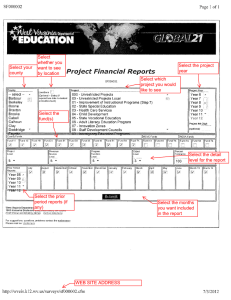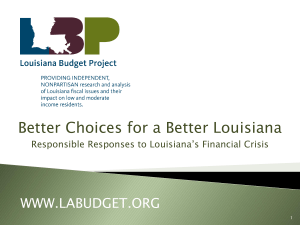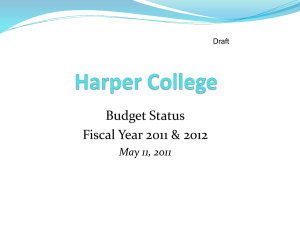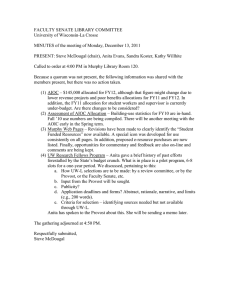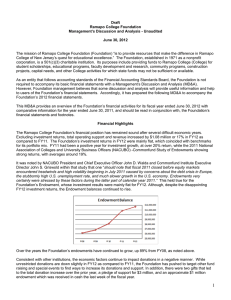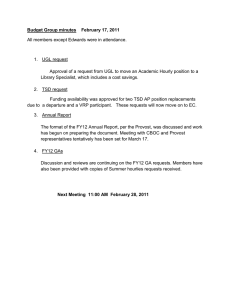ECONOMY UPDATE
advertisement
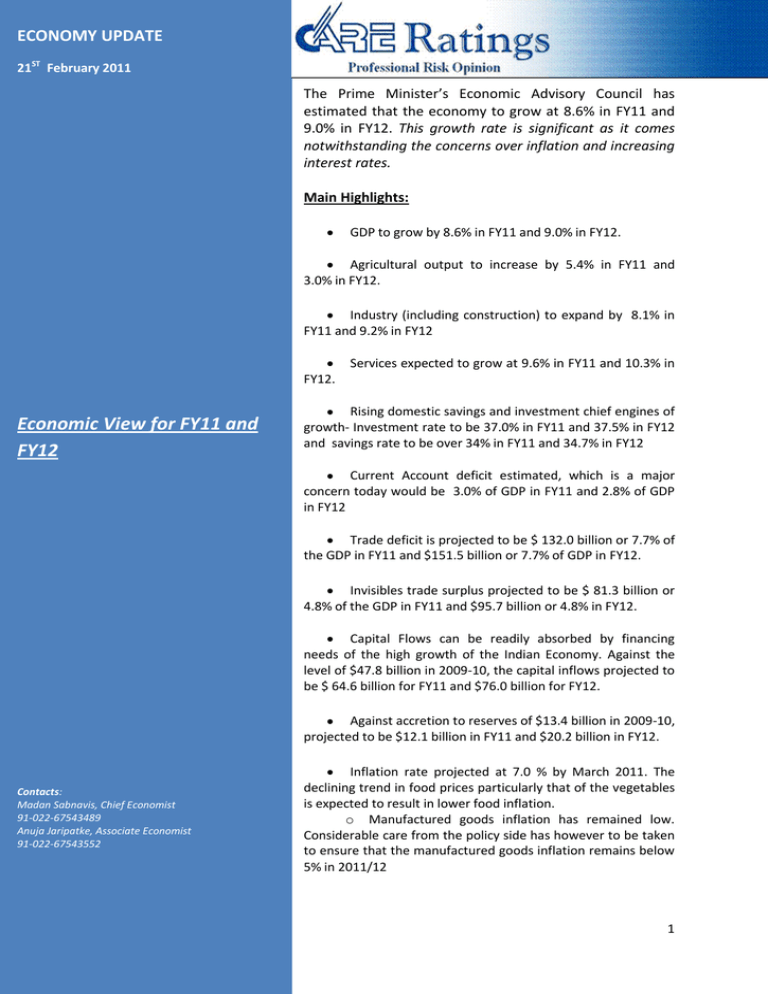
ECONOMY UPDATE 21ST February 2011 The Prime Minister’s Economic Advisory Council has estimated that the economy to grow at 8.6% in FY11 and 9.0% in FY12. This growth rate is significant as it comes notwithstanding the concerns over inflation and increasing interest rates. Main Highlights: GDP to grow by 8.6% in FY11 and 9.0% in FY12. Agricultural output to increase by 5.4% in FY11 and 3.0% in FY12. Industry (including construction) to expand by 8.1% in FY11 and 9.2% in FY12 Services expected to grow at 9.6% in FY11 and 10.3% in FY12. Economic View for FY11 and FY12 Rising domestic savings and investment chief engines of growth- Investment rate to be 37.0% in FY11 and 37.5% in FY12 and savings rate to be over 34% in FY11 and 34.7% in FY12 Current Account deficit estimated, which is a major concern today would be 3.0% of GDP in FY11 and 2.8% of GDP in FY12 Trade deficit is projected to be $ 132.0 billion or 7.7% of the GDP in FY11 and $151.5 billion or 7.7% of GDP in FY12. Invisibles trade surplus projected to be $ 81.3 billion or 4.8% of the GDP in FY11 and $95.7 billion or 4.8% in FY12. Capital Flows can be readily absorbed by financing needs of the high growth of the Indian Economy. Against the level of $47.8 billion in 2009-10, the capital inflows projected to be $ 64.6 billion for FY11 and $76.0 billion for FY12. Against accretion to reserves of $13.4 billion in 2009-10, projected to be $12.1 billion in FY11 and $20.2 billion in FY12. Contacts: Madan Sabnavis, Chief Economist 91-022-67543489 Anuja Jaripatke, Associate Economist 91-022-67543552 Inflation rate projected at 7.0 % by March 2011. The declining trend in food prices particularly that of the vegetables is expected to result in lower food inflation. o Manufactured goods inflation has remained low. Considerable care from the policy side has however to be taken to ensure that the manufactured goods inflation remains below 5% in 2011/12 1 Monetary Policy to complete the process of exit and operate with bias toward tightening of liquidity. Liquidity conditions are taut enough for monetary policy signals to be appropriately transmitted to the financial sector. Current year fiscal adjustment may not be a problem; the challenge is of adhering to the Finance Commission’s targets with credible expenditure management. Fiscal deficit outcome for FY11 could be marginally better than the budget estimates. o The consolidated fiscal deficit is likely to be 7.5 to 8 % of GDP for FY11. o There is considerable urgency in the implementation of goods and services tax (GST). o Budgeted level of Fiscal Deficit and Revenue Deficit still beyond comfort zone. Fiscal numbers to be better this year To sustain a growth rate of 9.0%, the following is required: Containing inflation by focusing both on monetary and fiscal policies and supply side management. The pace of infrastructure creation has to be stepped up with renewed focus on the power sector. Continue efforts to contain Current Account Deficit (CAD) at 22.5%of GDP and in parallel encourage flow of external investments into the country. Greater attention to agriculture including on seed development, management of water and soil fertility and improving delivery system. Challenges going ahead CARE Ratings’ View Growth of 8.5-9% for FY12 looks likely only in case monsoon is normal resulting in a good harvest. The structural factors that have caused inflation need to be addressed with urgency and will be a pre-condition to RBI relaxing interest rates. Industry will have to, operate under high interest rate conditions until such time that the RBI deems fit to lower them which will be contingent on inflation coming under control. The current account deficit will continue to come under pressure and attaining a level of 2.8% GDP will be a challenge given that the trade balance will increase in a growth phase of the economy. Capital inflows will have to be relied upon to ensure that the rupee is stable. A lot will depend on global economic recovery and flow of funds. Monsoon will remain critical Global developments to have a bearing -----------------------------------------------------------------------------------------------------------------------Disclaimer The Report is prepared by the Economics Division of CARE Limited. The Report is meant for providing an analytical view on the subject and is not a recommendation made by CARE. The information is obtained from sources considered to be reliable and CARE does not 2 guarantee the accuracy of such information and is not responsible for any decision taken based on this Report.
